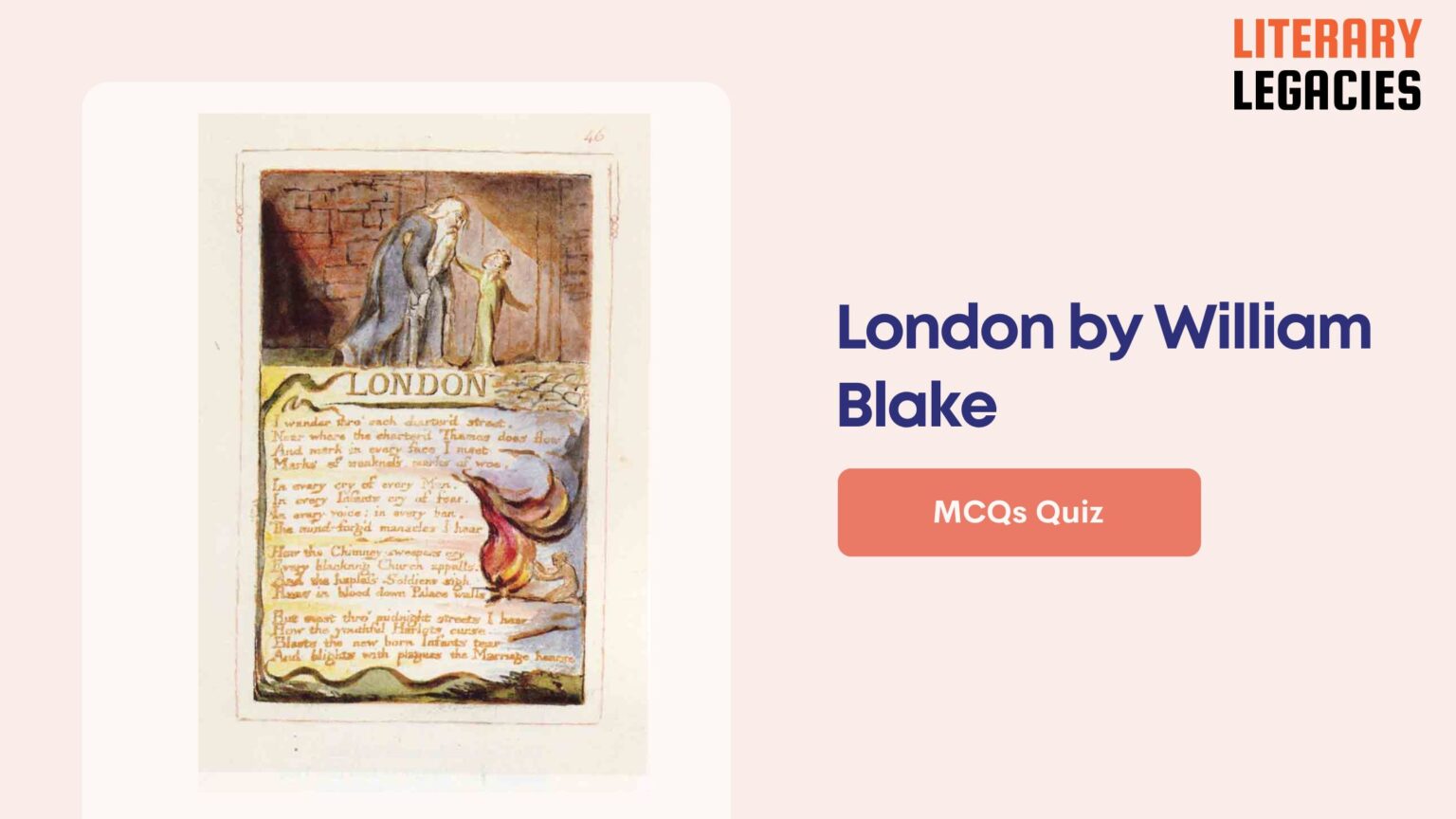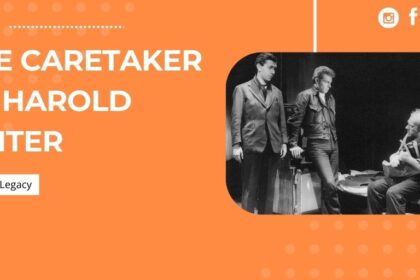1. What does the speaker primarily sense in the faces of people walking through London?
A. Indifference and apathy
B. Fear and sadness
C. Curiosity and excitement
D. Happiness and joy
Answer: Fear and sadness (B)
The speaker observes signs of resignation and sadness in the faces of those they encounter.
2. What recurring theme is evident in the speaker’s observations of London?
A. Wealth and prosperity
B. The plight of the oppressed
C. Hope amidst despair
D. Freedom from oppression
Answer: The plight of the oppressed (B)
The speaker senses feelings of being oppressed throughout the city, evident in the cries and expressions of its inhabitants.
3. Which imagery does the speaker use to express the suffering of British soldiers?
A. Their bravery depicted in paintings
B. Their blood staining the walls of a palace
C. Their sacrifices immortalized in monuments
D. Their heroism celebrated in parades
Answer: Their blood staining the walls of a palace (B)
The speaker imagines the blood of unfortunate British soldiers running down the palace walls, symbolizing their suffering and sacrifice.
4. What do the cries of young chimney-sweeps represent for the speaker?
A. Hope for a better future
B. A call for justice
C. Shame on the Church authorities
D. An expression of rebellion
Answer: Shame on the Church authorities (C)
The misery of young chimney-sweeps is seen as a source of shame for the Church, highlighting social injustice.
5. What does the term ‘Marriage hearse’ symbolize in the speaker’s imagery?
A. The intertwining of love and death
B. The joy of union in life
C. A celebration of marital love
D. The permanence of relationships
Answer: The intertwining of love and death (A)
The ‘Marriage hearse’ represents a surreal vehicle that symbolizes the coexistence of love and death.
6. What emotion do the cries of young prostitutes elicit in the speaker?
A. Joy and celebration
B. Empathy and sadness
C. Indifference and apathy
D. Relief and freedom
Answer: Empathy and sadness (B)
The sorrowful cries of young prostitutes contribute to the overall theme of misery heard by the speaker.
7. What aspect of city life does the speaker find oppressive?
A. The availability of jobs
B. The beauty of the architecture
C. The restrictions imposed by laws
D. The vibrant culture of London
Answer: The restrictions imposed by laws (C)
The speaker senses oppression in every law and restriction placed on the population, influencing their perception of city life.
8. How does the poem depict the act of exchanging one’s body in the context of survival?
A. As a means of achieving freedom
B. As a celebratory ritual of life
C. As a voluntary act for prosperity
D. As a tragic necessity for survival
Answer: As a tragic necessity for survival (D)
The poem illustrates the exchange of bodies as a tragic necessity, revealing the desperate conditions people face.
9. What is the implication of the closing images of ‘youthful Harlots’ and ‘new-born infants’?
A. The potential for societal change
B. Hope for a better future generation
C. The celebration of new beginnings
D. An initiation into a life of suffering
Answer: An initiation into a life of suffering (D)
These images suggest that the new generation will inherit the ongoing cycle of poverty and suffering.
10. What does the term ‘mind-forg’d manacles’ suggest about society in the poem?
A. People are metaphorically imprisoned by their thoughts.
B. Society is held back by physical constraints.
C. Society has found effective ways to escape its problems.
D. Freedom is achievable for everyone in society.
Answer: People are metaphorically imprisoned by their thoughts. (A)
The term indicates that the barriers to freedom are self-imposed limitations in thought and perception.
11. In what way does the poem reflect on the outcomes of the Industrial Revolution?
A. It praises the economic growth and job creation.
B. It focuses on technological advancements in urban life.
C. It celebrates the cultural shifts of the period.
D. It highlights the social struggles and decline in living conditions.
Answer: It highlights the social struggles and decline in living conditions. (D)
The poem critiques the negative social impacts and hardships that arose alongside industrial advancements.
12. What overarching theme does the poem suggest regarding life in urban environments?
A. Individual freedom is enhanced in urban settings.
B. There is a recurring cycle of poverty and despair.
C. Urban life provides numerous opportunities for wealth.
D. Community bonds are strengthened in cities.
Answer: There is a recurring cycle of poverty and despair. (B)
The poem illustrates the cyclical nature of poverty, indicating that urban life often perpetuates suffering.
13. What is the poem’s stance on hope and change in society?
A. Society is filled with hope for drastic transformations.
B. Societal change is inevitable and already happening.
C. There is little to no hope for societal improvement.
D. Hope exists, but requires substantial effort to achieve.
Answer: There is little to no hope for societal improvement. (C)
The poem emphasizes a grim outlook, suggesting that hope for societal change is nearly nonexistent.
14. Which of the following best describes the poem’s view on the future generations?
A. They will thrive in an improved society.
B. They will bring about a revolution for change.
C. They will inherit the same struggles faced by their parents.
D. They will have fewer challenges than previous generations.
Answer: They will inherit the same struggles faced by their parents. (C)
The poem indicates that future generations are destined to face the same societal issues and hardships.
15. How does the poem frame the concept of urban woes?
A. As an inevitable aspect of life in cities.
B. As a temporary phase in societal development.
C. As easily solvable through community efforts.
D. As something that enhances human resilience.
Answer: As an inevitable aspect of life in cities. (A)
It portrays urban woes as a persistent and inescapable reality for those living in the city.
16. What emotional tone does the poem convey regarding city life?
A. Neutral and detached
B. Chaotic yet vibrant
C. Hopeless and oppressive
D. Optimistic and celebratory
Answer: Hopeless and oppressive (C)
The poem conveys a tone of hopelessness and oppression, indicating the harsh realities faced by city dwellers.
17. Which aspect of modern city life does the poem criticize most harshly?
A. The cultural diversity in urban settings.
B. The rapid economic growth and prosperity.
C. The artistic expressions of city residents.
D. The lack of freedom and oppressive conditions.
Answer: The lack of freedom and oppressive conditions. (D)
The poem focuses on the oppressive conditions that limit freedom and perpetuate suffering in urban life.
18. What symbolizes the oppressive nature of society in Blake’s depiction of London?
A. The vibrant art scene
B. The bustling market life
C. The beautiful parks
D. The dirty and dangerous city
Answer: The dirty and dangerous city (D)
Blake’s portrayal of London highlights it as a dirty and dangerous environment that epitomizes human depravity.
19. What does the phrase ‘mind-forg’d manacles’ imply about the nature of suffering in London?
A. Suffering is caused mainly by physical restraints.
B. Only the wealthy can escape from suffering.
C. Suffering comes from societal thoughts and conventions.
D. Suffering is transient and can be easily resolved.
Answer: Suffering comes from societal thoughts and conventions. (C)
The phrase suggests that the suffering experienced by Londoners is born from the way society and individuals think about themselves.
20. How does Blake view the societal changes brought by the Industrial Revolution?
A. As something that diminishes the human experience.
B. As a necessary stage for progress and growth.
C. As a beneficial influence on human relationships.
D. As an opportunity for social equity.
Answer: As something that diminishes the human experience. (A)
Blake argues that the Industrial Revolution leads people to lose sight of their humanity, making the urban environment oppressive.
21. What effect does the speaker perceive that the city has on its inhabitants?
A. It promotes personal freedom and joy.
B. It enhances artistic expression.
C. It cultivates community spirit.
D. It leads to despair and oppression.
Answer: It leads to despair and oppression. (D)
The speaker observes that the city’s oppressive nature results in despair among its inhabitants.
22. Which group does the speaker highlight as particularly vulnerable in London?
A. The chimney-sweepers and harlots
B. The soldiers and wealthy merchants
C. The affluent business owners
D. The artists and poets
Answer: The chimney-sweepers and harlots (A)
The speaker emphasizes how children involved in chimney sweeping and female prostitutes endure severe hardships to survive.
23. Which of the following illustrates the speaker’s feelings about newborns in London?
A. They symbolize the city’s vibrancy.
B. They represent hope and renewal.
C. Their cries echo the city’s pervasive pain.
D. They are a sign of prosperity.
Answer: Their cries echo the city’s pervasive pain. (C)
The speaker suggests that the cries of newborns reflect the overarching sorrow present in the city.
24. What aspect of the Thames does the speaker focus on in relation to freedom?
A. Its constricted and predetermined course.
B. Its connection to historical events.
C. Its scenic beauty during sunset.
D. Its role as a trade route.
Answer: Its constricted and predetermined course. (A)
The speaker uses the Thames as a symbol of lost freedom, noting that its course has been constrained, reflecting the lack of liberty in the city’s life.
25. What does the overall tone of the poem suggest about urban life in London?
A. It is diverse and welcoming.
B. It is celebratory and thriving.
C. It is peaceful and tranquil.
D. It is harsh and oppressive.
Answer: It is harsh and oppressive. (D)
The overall tone of the poem communicates a sense of harshness and oppression experienced in urban life.
26. What does Blake imply about the fundamental nature of society through his depiction of London?
A. Society thrives on communal harmony and shared beliefs.
B. Society flourishes through individuality and capitalism.
C. Society is inherently flawed due to greed and power dynamics.
D. Society is best when focused on technology and industry.
Answer: Society is inherently flawed due to greed and power dynamics. (C)
Blake portrays the view that greed, fear, and the thirst for power lead society to a fundamental flaw that results in misery.
27. What desperate measures do people resort to, according to the speaker?
A. Engaging in acts of community service.
B. Participating in artistic endeavors.
C. Selling their bodies or risking their health.
D. Seeking refuge in rural areas.
Answer: Selling their bodies or risking their health. (C)
The speaker notes that individuals like the chimney-sweepers, soldiers, and harlots must resort to desperate and harmful measures for survival.
28. What does the speaker suggest about the impact of the adult world on children in London?
A. It helps them adapt quickly to urban life.
B. It encourages their natural innocence to flourish.
C. It provides them with opportunities to learn.
D. It leads to their emotional and physical corruption.
Answer: It leads to their emotional and physical corruption. (D)
The speaker details how children are distressed and corrupted by the adult world.
29. Which profession is highlighted as particularly harmful to children in Blake’s portrayal of London?
A. Chimney-sweeping
B. Dock work
C. Working in factories
D. Street vending
Answer: Chimney-sweeping (A)
The poem points out chimney-sweeping as a brutal profession that harms children.
30. What metaphor does Blake use to illustrate the oppression of children in the urban environment?
A. Chains of ignorance
B. Mind-forg’d manacles
C. Walls of poverty
D. Shackles of despair
Answer: Mind-forg’d manacles (B)
The phrase ‘mind-forg’d manacles’ represents the societal constraints affecting children.
31. How does the speaker depict the initial experiences of newborns in London?
A. As blissful and serene
B. As painful and full of fear
C. As vibrant and lively
D. As joyful and filled with potential
Answer: As painful and full of fear (B)
Newborns are described as feeling fearful and distressed from the moment they arrive.
32. What cycle of misery is illustrated through the speaker’s observations of urban children?
A. Miserable mothers create more miserable children
B. Wealth leads to poverty
C. Miserable parents create happy children
D. Children escape the cycle through education
Answer: Miserable mothers create more miserable children (A)
The speaker highlights the ongoing cycle where unhappy parents lead to unhappy children.
33. Which of the following statements reflects Blake’s view on childhood in London?
A. Childhood experiences do not affect future happiness.
B. Childhood should be a time for joy and learning.
C. Childhood is a privilege of the wealthy.
D. Childhood is inherently filled with suffering.
Answer: Childhood should be a time for joy and learning. (B)
Blake believes children should experience joy and love, not suffering.
34. What does the term ‘blasted’ imply about the experiences of newborns in the poem?
A. They achieve immediate acceptance in society.
B. They are welcomed with love.
C. They are celebrated and cherished.
D. They are condemned to sadness from birth.
Answer: They are condemned to sadness from birth. (D)
‘Blasted’ indicates that newborns face hardship and sadness even at the outset of life.
35. How is the theme of maternal influence depicted in regard to children’s suffering?
A. Children’s suffering is independent of maternal circumstances.
B. Maternal love directly alleviates childhood suffering.
C. Mothers’ suffering perpetuates children’s suffering.
D. Mothers are solely responsible for children’s happy lives.
Answer: Mothers’ suffering perpetuates children’s suffering. (C)
Blake illustrates a cycle where the distress of mothers contributes to the distress of children.
36. In Blake’s view, what essential aspect of childhood is compromised in urban life?
A. Access to education
B. Nurturing environments
C. Connection to nature
D. Opportunities for play and growth
Answer: Opportunities for play and growth (D)
Children in urban settings are forced to sacrifice their childhood experiences for survival.
37. What broader societal issue does Blake’s depiction of childhood suffering point to?
A. The effects of industrialization and urbanization
B. The need for stricter labor laws
C. The importance of economic stability
D. The value of education in society
Answer: The effects of industrialization and urbanization (A)
Blake critiques industrialization and urban living conditions as sources of childhood corruption.



